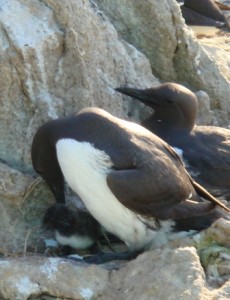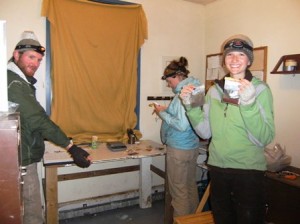So, first, a quick clarification. There are two houses on the island–they are identical, and were designed as duplexes (each for two families) back when the lighthouse keepers and their families still lived on the island. One, the one all the biologists and interns live in, is called the PRBO House. The other is called the Coast Guard House, but no one lives in it for now. We call it that because it is their property. When coast guard people come out here to do work, that is where they stay. When they’re not here, it serves as our exercise/shower/tv headquarters, and our overflow house. So, on the rare occasion that we have guests, they stay there.
For example, tomorrow! Tomorrow, Gerry McChesney, the Farallones Refuge manager, will be coming out here and staying for a week. In tow, he wil be bringing the first of two film crews that are going to be visiting the island over the course of the next week. Both are crews from PBS, and they are each filming documentaries. One will be a documentary called “California Gold,” so I assume it’s about the Gold Rush. The Farallones, during the gold rush, provided a source of eggs for the miners, before chickens were brought to California. The other documentary is some sort of nature thing, presumably about birds.
Tomorrow, according to Pete, I will probably be taking the film crew around on my daily chick checks, so stay tuned for me to become super famous. Potentially.
So anyway! About today! Today was epic. Started out with my standard corm re-sights, and then lunch. Without many cormorants to monitor, I spent a lot of time watching one of the murres, whose chick has hatched:
I think he is very cute, and the parents don’t let him out very often, so glimpses of him are rare.
After lunch is when things got crazy. Today was the day for a fifteen-day chick check that occurs as part of the Known Age/ Old Age Cassin’s auklet Study. This study focuses (as you may have guessed from the title) only on birds that have been banded here in the past, so that we know how old they are, and follows their chicks and reproductive success. That study happened to correspond with a different study, during which we visit all of the Auklet Boxes, no matter whether the parents’ age is known or not, and band the chicks, so that those birds will, in the future, become known age birds. This meant there were 402 Cassin’s Auklet Boxes to check for chicks. The majority of these chicks had to be weighed, and 128 of them had to be banded. That is a LOT of work! Banding birds can be a relatively slow process, since we try very hard to make sure the bands won’t come off, and won’t catch on anything during the bird’s lifetime. It took three and a half hours this afternoon, which is a long time to be kneeling on the ground in front of auklet boxes.
Following the auklet study, Claudia took me around to her Western Gull (WEGU) plot, which I will be taking over when she leaves in two weeks. It seems like a very complicated, relatively frustrating study, but hopefully I will get the hang of it. After that, more corm resights, and then a delicious dinner cooked by Russ.
After dinner tonight was my first night work here on the island, and today, we were collecting diet samples from Cassin’s Auklets, or, to put it more directly, barfing them. Barfing Cassin’s Auklets is pretty much exactly what it sounds like. The adult birds return to the island at night, with little pouches under their necks full of chewed up food to feed to their chicks. To catch the birds, we sit in the dark, waiting to hear the thud of the bird as it lands on the ground (two of them actually ran right into my face though, so maybe they don’t have much better night vision than we do). When one hears the “thud,” you switch on your headlamp quickly and lunge at the bird. Five times out of six, you miss, because they’re very fast and small. However, occasionally, you don’t miss, and you grab the bird. Almost immediately, the bird begins to vomit, so you have a VERY short window during which to shove its head into a plastic sample bag. Then, you have to massage its throat, to make sure you get all the food out. Pretty nasty, and it smells a lot like fish.
After we got our samples, we took them back to the diet lab. Here’s with me with the ones I collected! Yum yum:
The samples are mainly composed of krill and fish bits, but a cursory glance revealed some barnacle larvae as well. My hands, despite having been washed, do smell pretty bad now, but that will probably go away soon.
All of the samples we collect are placed in bags, and the bags are labelled carefully and placed in the freezer. At the end of the season, we will mail them to an expert, who will spend a long time picking through these diet samples, and figuring out just what is in them.
Overall, a fun and exciting night!
As far as unusual bird sightings, I spotted a Heerman’s gull today. Not all that uncommon, but certainly more common south of where we are right now. Molly, the Brant Goose, is still limping around, defying the odds. Also, two common ravens have taken to harrassing some of our murres, and I hope they go away.
Well, I’m off to bed. Up early tomorrow to start a new study, diet watches (more on that later)!
Best,
Eleanor


